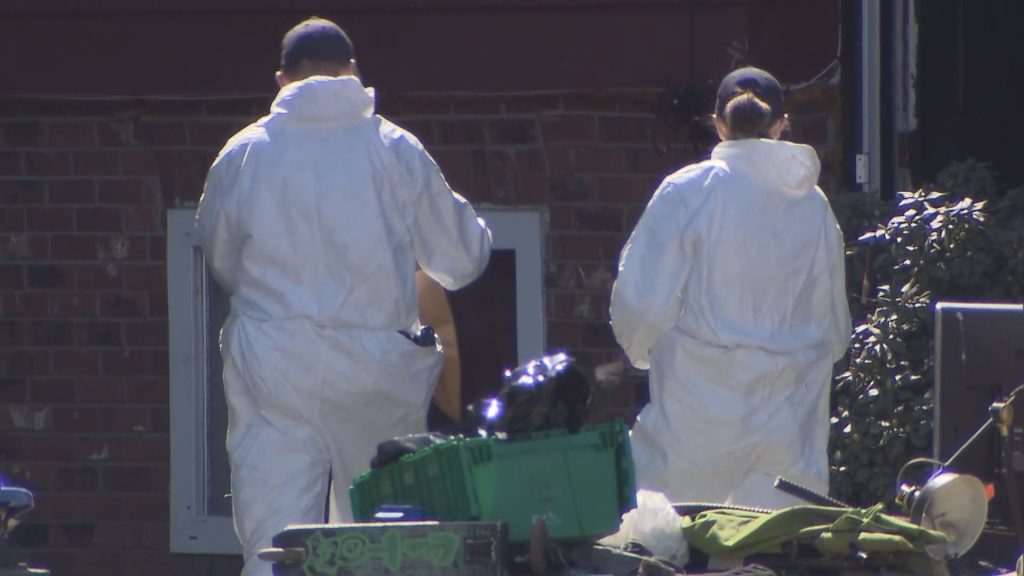A first public viewing of Lac-Megantic blast zone reveals site still scorching
Posted July 16, 2013 11:30 am.
This article is more than 5 years old.
LAC-MEGANTIC, Que. – A first public glimpse of the disaster site in Lac-Megantic left stunned visitors staring Tuesday at three-storey buildings reduced to piles of brick, road asphalt melted into bubbly tar, and pine trees scorched into sticks of charcoal.
Burnt rail tankers are still steaming with heat, more than a week after the explosions. The temperature near the blast site remains, according to authorities, 10 to 20 degrees higher than elsewhere.
News media were allowed behind the walls of the security perimeter for the first time, in order to let them observe the scene and share what they saw with the broader public. Until Tuesday, only civil authorities and visiting politicians had viewed the site.
The tour began with a warning.
“Just listen and look at the scene; stay quiet and think about what happened; and explain what happened to the rest of the world,” provincial police Lt. Michel Brunet told reporters before the tour.
Still, visitors weren’t entirely prepared for what they saw when they ventured onto the site — which Prime Minister Stephen Harper had previously described a “war zone” after he visited.
The destruction was so shocking that one local reporter burst into tears.
During the hour-long visit, a group of journalists were brought inside the perimeter by bus then taken on a closely-monitored walking tour.
The burnt tanker cars, once filled with crude oil, remained smashed and piled together 10 days after a fast-moving runaway train derailed near the centre of town.
The faint smell of gas and something like burnt rubber grew stronger as police led the group closer to the epicentre of the explosions.
Mechanical diggers clanged as they dug through the rubble alongside a group of a dozen firefighters and search crews.
Those crews found one more body Tuesday — the 38th recovered on the site. Fifty people are believed to have died in the disaster.
As evidence of the force of the explosions, police pointed to a single, charred rail axle lying in the middle of an empty parking lot, at least 50 metres from the tankers.
Elsewhere, a portion of track had been twisted into an arch more than a metre high.
The visit revealed a surreal disparity.
Along the town’s main strip, a row of buildings on either side had been completely destroyed in the explosions, while in the other direction storefronts and cafe patios were undamaged.
That’s because the scalding oil leaked downhill, towards the lake, bringing flames that roared through everything in their wake, police said.
The only marker for Musi-Cafe, the popular bar where many people died, was a tent put up to shade workers as they searched for bodies.
On the street, the faint outline of a blackened licence plate offered only the slightest hint that a mangled block of metal was once a car.
A reporter with the local paper, L’echo de Frontenac, wept.
“I’m not capable, right now, of describing the feeling,” said Claudia Collard, whose own offices are inside the perimeter.
The paper still hasn’t missed an edition following the explosion. Collard said she felt the need to express to residents what it was like on the inside.
“I think it’ll be easier later, when I’m writing,” she said. “Maybe it’s a little like losing a loved one.”
The lakeside boardwalk, more than 500 metres from where the tankers derailed and first exploded, was covered with bits of brick, glass and ash.
Many of the trees in the waterfront park were also destroyed.
Another local reporter, who was born in Lac-Megantic, said he was encouraged to see that the park gazebo, the site of so many musical performances, had somehow escaped unscathed.
A pair of workers used a vacuum hose to collect the swirls of crude oil floating on the surface of the lake. Floating barriers lined the water to prevent it from spreading further.
More than 100,000 litres of oil spilled into the water system following the disaster.
Police handed out water bottles to reporters, warning the heat and difficult conditions had caused problems for some of the work crews.
Firefighters have been limited to 15-minute shifts to avoid heat exhaustion.
Investigators said they wanted the broader public to see what happened in Lac-Megantic.
“The goal that we had today with the members of the media was to render to the community the most factual and most recent images of the downtown,” said provincial police Insp. Michel Forget.
“(Another objective was to) also see the scope of the work.”
The perimeter, which is blocked by a high metal fence lined with black cloth, has attracted a steady stream of visitors trying to get a peek for themselves.
Police gave strict instructions about what images could be shown for fear of upsetting the families of victims, or compromising the investigation.
Only one TV cameraman, one web-video journalist, one photographer, and one radio reporter were allowed to record inside the perimeter.
The images gathered from Tuesday morning’s media pool were shared with other news outlets, then released to the public.
Forget made it clear that journalists were not actually inside the so-called “red zone” — the epicentre of the blast — but taken inside the closed-off area to record images of it from the edges.
Brunet said it’s impossible to predict how long officials will be on the site.
He said the devastation is something that he and other members of the force will never forget.
“It’s impossible,” he said.
“People tell me, ‘Don’t leave until you find my son.'”










